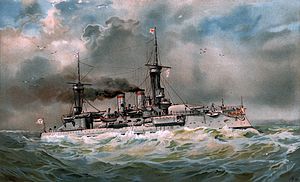SMS Brandenburg

Painting of SMS Brandenburg in 1902
|
|
| History | |
|---|---|
|
|
|
| Name: | Brandenburg |
| Namesake: | Province of Brandenburg |
| Builder: | AG Vulcan Stettin |
| Laid down: | May 1890 |
| Launched: | 21 September 1891 |
| Commissioned: | 19 November 1893 |
| Fate: | Scrapped in 1920 |
| General characteristics | |
| Class and type: | Brandenburg-class battleship |
| Displacement: | 10,670 t (10,500 long tons) |
| Length: | 115.7 m (379 ft 7 in) |
| Beam: | 19.5 m (64 ft 0 in) |
| Draft: | 7.9 m (25 ft 11 in) |
| Installed power: | 10,000 ihp (7,500 kW) |
| Propulsion: | 2-shaft triple expansion engines |
| Speed: | 16.9 knots (31.3 km/h; 19.4 mph) |
| Range: | 4,300 nautical miles (8,000 km; 4,900 mi) at 10 knots (19 km/h; 12 mph) |
| Complement: |
|
| Armament: |
|
| Armor: | |
SMS Brandenburg was the lead ship of the Brandenburg-class pre-dreadnought battleships, which included Kurfürst Friedrich Wilhelm, Weissenburg, and Wörth built for the German Kaiserliche Marine (Imperial Navy) in the early 1890s. She was the first pre-dreadnought built for the German Navy; earlier, the Navy had only built coastal defense ships and armored frigates. The ship was laid down at the AG Vulcan dockyard in 1890, launched on 21 September 1891, and commissioned into the German Navy on 19 November 1893. Brandenburg and her three sisters were unique for their time in that they carried six heavy guns instead of the four that were standard in other navies. She was named after the Province of Brandenburg.
Brandenburg saw her first major deployment in 1900, when she and her three sister ships were deployed to China to suppress the Boxer Rebellion. Upon returning to Germany, Brandenburg and her sisters, with the exception of Wörth, took part in extensive fleet maneuvers in 1902. In the early 1900s, all four ships were heavily rebuilt. However, she was obsolete by the start of World War I, and only served in a limited capacity, initially as a coastal defense ship, but primarily as a barracks ship. Following the end of the war, Brandenburg was scrapped in Danzig in 1920.
Brandenburg was 115.7 m (379 ft 7 in) long, with a beam of 19.5 m (64 ft 0 in) and a draft of 7.6 m (24 ft 11 in). Brandenburg displaced 10,013 t (9,855 long tons) as designed, and up to 10,670 t (10,501 long tons) at full combat load. She was equipped with two sets of 3-cylinder vertical triple expansion steam engines that produced 10,000 indicated horsepower (7,457 kW) and a top speed of 16.9 knots (31.3 km/h; 19.4 mph) on trials. Steam was provided by twelve transverse cylindrical water-tube boilers. She had a maximum range of 4,300 nautical miles (8,000 km; 4,900 mi) at a cruising speed of 10 knots (19 km/h; 12 mph). Her crew numbered 38 officers and 530 enlisted men.
...
Wikipedia
